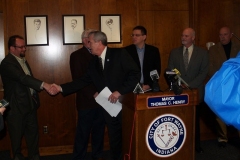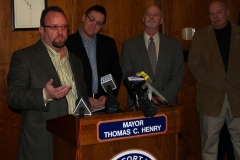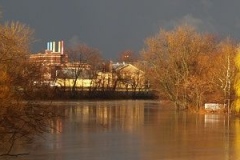Realistic riverfront opportunities in Fort Wayne, Indiana. Â (Map provided by Dan Wire)
One of the ideas debated in the recent Charis House proposal for Fairmount Place was that of riverfront development. Â It was argued by some that this was one of the last areas left that could be developed utilizing it’s close proximity to the river.
Others argued that the levees prohibit the development of anything to do with the river because of it’s cutting off the view or easy access. Â Following this logic denies the fact that a business can be successful in overcoming a levee, such as the Fort Wayne Outfitters on Cass Street. Â You have to climb up, then over and down a steep bank to reach the river, yet people do this on a daily basis to launch into the St. Mary’s in available rental kayaks. Â There are also ways to overcome a levee, or work within it’s constraints to provide access to a “blocked off” river.

A case in point here would be Clinton Street just south of the Fourth Street intersection. Â Clinton cuts through the levee and removable flood gates can be installed if needed.
The plain truth of the matter is that there are very few areas left in Fort Wayne where easy access could be had as proven by the above map. Â When I put the question to readers earlier this year about potential uses for the Fairmount Place property, the responses contained many thoughtful ideas. Â The citizens of this community, as demonstrated by the response to my questions as well as the BluePrint, BluePrint Plus and North River Now Charrettes was overwhelmingly in favor of the rivers playing a viable part in this community. Â Yes, the rivers are mucky and contaminated – but that is today. Â There is a huge movement to clean the rivers up which is fueled by the City’s own project to limit Combined Sewage Overflows (CSO). Â If we don’t do something to reserve the few available opportunities to be on the river for when we can avail ourselves of them, we will only regret it years down the road.
Next week, the Plan Commission has the opportunity to address not only riverfront development, but bigger picture, the value of the Community Development Area Plans (CDAPs) that so many citizens in the community in various neighborhoods, have at their own time and expense, developed. Â It was demonstrated in one of the public hearings on the Fairmount Place topic by almost a dozen different neighborhood leaders who testified before the Plan Commission citing various passages from their CDAPs, that the citizens care and want riverfront development. Â Not only do they want it, but they have allowed for it in their plans. Â To allow the development to go forward flies in the face of the hard work of the citizens of this community.
I might also add that one thing the City should consider is this. Â There has been talk in the meetings of the fact that if Charis House develops the property as proposed, the City will have to install – at considerable expense to taxpayers – a pumping station to alleviate flooding on the property. Â Charis House is operated as a non-profit entity which means it does not pay property taxes. Â The City will spend many dollars – dollars which could go toward concrete work on the various streets in our city that need it, or possibly even toward the CSO project or a myriad of other needs throughout our City to recoup nothing through property taxes. Â It will not recoup anything from income taxes or sales tax paid by potential businesses that could operate on such a site.
Yes, the Charis House employees will pay income taxes, but these are already paid at their current facility and any added staff because of the enlarged site would never put the City in a position to recoup it’s investment in any kind of timely fashion. Â If the Charis House insists on developing this property, they should also expect to pay the costs of providing itself with needed flood protection. Â If the Charis House were a for-profit entity, then at least we taxpayers would see some of the investment returned.
It can be argued that the value of the services Charis House provides are of value to the community. Â But, this value does not pay back in real dollars the investment of such a pumping facility. Â So the question really becomes, is this the best place for such a project? Â Does it have to be built on one of the few available properties left for potential riverfront development? Â Should we throw out the plans and desires of a neighborhood, City and County? Â Or can it be built elsewhere leaving this property open for consideration in other projects? Â As Councilman Tim Pape has stated, just because an opportunity or project is proposed doesn’t mean it’s a good fit and should be embraced. Â Plans are made for a reason – to help evaluate how those opportunities and projects fit in with the community, if at all.
Our rivers can be a viable part of our community again – if we don’t squander the precious few resources left to us. Â Jack Murrah, from Chattanooga, Tennessee, was recently in town to talk to community leaders and citizens about riverfronts, downtowns and revitilization. Â One of the most memorable quotes from Jack was, “Good places don’t happen by accident, nor do bad places. We tend to get the kind of communities we deserve.” Â This needs to become an embedded part of our guiding doctrine whenever and wherever proposed developments are discussed.
My good friend Dan Wire, when he sent the above map to me, wrote, “I dare anyone to address head-on the realistic riverfront opportunities.” Â I join him in calling on the Plan Commission to allow the room to dream a little about our riverfronts.
















